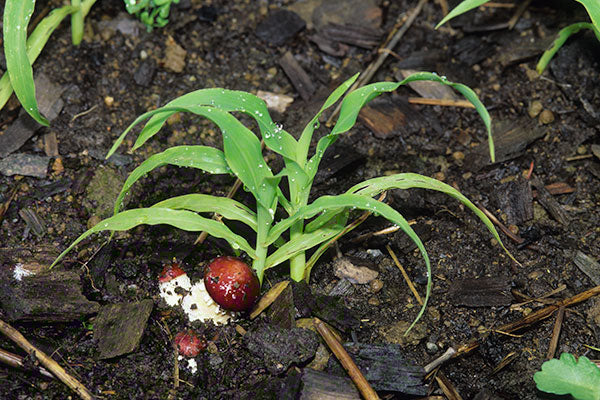
Companion Planting with the Garden Giant

Chances are that if you have perused the Fungi Perfecti catalog or web site, you have probably heard of the "Garden Giant" mushroom (Stropharia rugoso-annulata). Additionally, if you have read mycologist and Fungi Perfecti founder Paul Stamets' book, Mycelium Running, you may also know a bit about this species' role in fungal bioremediation. What you may not know, however, is that if you engaged in a little Garden Giant companion planting last season, the mycelium is already hard at work helping to protect and groom your garden.

| Garden Giant mycelium thriving at the mulch-soil interface. Photo by Nick Bernat. |
Among the many fascinating features of this species is a tendency toward tenacious growth on unbelievably diverse materials. From corn stalks to straw…from conifer duff to hardwood chips…the Garden Giant can digest them all. It can accomplish this remarkable feat primarily because of its unique suite of "leaf litter decomposing" enzymes. The Garden Giant is unique in that it can grow as either a primary or secondary decomposer. This trait allows it interface readily between the topsoil and mulch layer in your garden. As spring temperatures warm and your Garden Giant "wakes up," it is actively digesting and re-mobilizing last season's refuse into this summer's fertile substrate.
These benefits may be obvious for the observant organic gardener, but what may be less obvious is the Garden Giant’s guardianship of the microscopic microbial landscape. In the late 1980s, Paul Stamets determined that a serendipitously placed Garden Giant mushroom bed was responsible for reducing bacteria runoff from upland pasture at his western Washington farm. Following this initial inspiration, several years of small experiments, an EPA storm-water management innovative research grant, and some large-scale field trials have documented that the mycelium of the Garden Giant mushroom can improve the ability of mulch to filter and remove E. coli. Further, Stropharia rugoso-annulata mycelium produces spiky crystalline-like spherical structures called "acanthocytes." In 2005, researchers at Yunnan University and Kunming University of Science and Technology documented that these acanthocytes act as nematode-destroying microscopic barbs that eviscerate these garden pests as they pass by the mycelium in the soil (see Hong et al., 2006).
As if that weren’t enough, in the fascinating world of microbial ecology even the bad guys are sometimes good. Many indoor mushroom cultivators are all too familiar with the dreaded green mold "Trichoderma." Garden mushroom cultivation, however, has its advantage here as well. If a bit of green mold should encroach and feed upon your Garden Giant mycelium, it may not be all bad. Many Trichoderma species are also extremely antagonistic to common plant microbial pathogens such as Phytophthora spp. and Pythium spp. (see Howell, 2003).
So, if spring fever is starting to set in but the ground may yet be a bit cold for your seeds, take heart and thank yourself for making a wise choice last summer when you "myco-mulched." Your fungal allies are waking up and starting to preen that spring soil. If you didn't know how beneficial and easy fungal companion planting can be, there is no need to fret. Spring is also a great time to start the process as you mulch those freshly weeded beds!

| Garden Giant mushrooms flourishing in a bed of corn plants. Photo courtesy of J. Muir. Read J's. |
